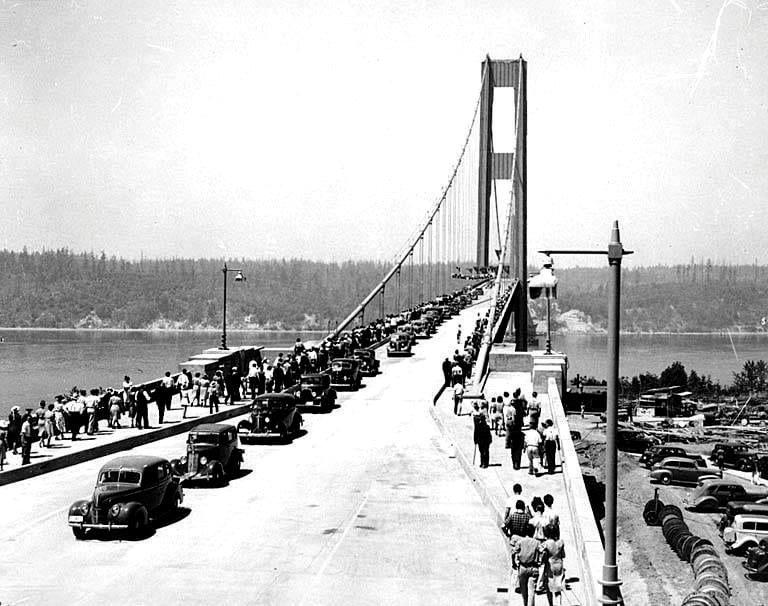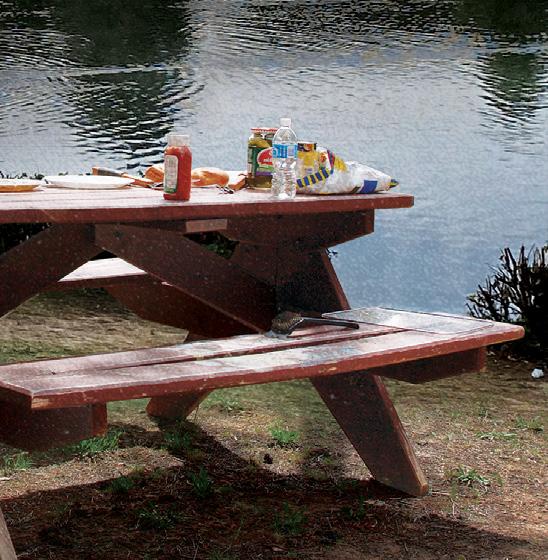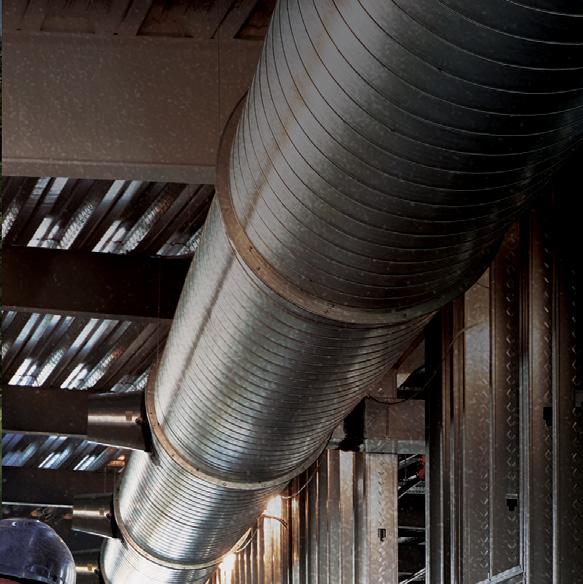
16 minute read
Historic Structures
Tacoma Narrows Bridge Failure 1940
Galloping Gertie, Part 1
By Frank Griggs, Jr., Dist. M.ASCE, D.Eng, P.E., P.L.S.
The collapse of the Tacoma Narrows Bridge is one of the most well-known of all bridge failures as its collapse was caught on fi lm. Th e fi lm was and still is viewed in many introductory physics classes.
Planning for the bridge started in 1929, just before the Great Depression, when proponents of the bridge, including the Tacoma Chamber of Commerce, pushed for its construction. It was to cross an arm of Puget Sound, the Tacoma Narrows Strait in the State of Washington connecting Tacoma with Gig Harbor.
In 1929, D. B. Steinman proposed a suspension bridge followed in 1931 by a cantilever bridge by the Tacoma City Engineer. In 1932, a local engineer formed the Tacoma Bridge Company that hoped to raise at least $3.5 million to construct a Narrows suspension bridge. Th e Corps of Engineers approved his plan, but the Reconstruction Finance Administration (RFA) would later propose a cantilever bridge as preferable. In the late 1930s, the Washington State Legislature created the Washington Toll Bridge Authority to fi nance and operate bridges in the State, including the Tacoma Narrows.
It should be understood that, by this time, New York City had built the Brooklyn Bridge in 1883, the Williamsburg Bridge in 1903, the Manhattan Bridge in 1909, and the George Washington Bridge in 1931. Also, for the record, the Wheeling Bridge by Charles Ellet, Jr. (1849), the Lewiston-Queenston Bridge (1851) by Edward W. Serrell, and the Niagara Clifton Bridge (1899) by Leff ert L. Buck had all been destroyed by the action of winds. Th ese failures were well documented in the literature of the day.
Signifi cant changes in suspension bridge design occurred between 1903 and 1909, incorporating the Austrian Josef Melan's deflection theory. Melan’s main breakthrough was the understanding that the deck and the cables act together to carry vertical loading and that, as the span length increased with greater dead loads, the need for a stiff ening truss was reduced greatly. Leon Moisseiff , then working for the City of New York, translated Melan’s work and applied it to the design of the Manhattan Bridge with its 1,590-foot span and 25-foot-deep stiff ening truss. Next, O. H. Amman applied it to the design of the George
Tacoma Narrows Bridge on opening day. Washington Bridge, when he virtually eliminated all deck trussing, relying on the weight of the cable only for roadway stiff ness. Th e Williamsburg Bridge by Leff ert L. Buck, with its 40-foot-deep stiff ening truss, was the last major bridge to be built using the elastic method fi rst proposed by William M. Rankine. Finally, on the Golden Gate Bridge, Joseph B. Strauss and Charles Ellis, with Leon Moisseiff , used a stiff ening truss of a far lesser depth than the shorter Williamsburg Bridge. Moisseiff also applied it to the Bronx Whitestone Bridge across the East River in New York City, built between 1936 and 1939. Th e fi rst design for the Tacoma
Moissei believed that its Narrows Bridge by the Washington Toll Bridge Authority was by Clark sti ness depended on structural Eldridge, an engineer for the state. It weight and proportion and that was a conventional suspension bridge with a 25-foot-deep stiff ening truss on he “could reduce truss depth either side of the roadway to resist the strong Narrows winds. He estimated without adversely a ecting the cost of the bridge at $11,000,000. Its main span was 2,600 feet with side bridge sti ness.” spans of 1,300 feet and a sag of 260 feet. Th e Director of the Washington State Highway Department took the









design to the Public Works Administration (PWA) and, by most accounts, they determined the $11 million was excessive and urged the state to contact Leon Moisseiff and the fi rm of Moran & Proctor for a cheaper design, which they did. J. J. Madigan, the head of the PWA, later wrote, “In no instance did this Administration nominate or express any preference for any particular individual, group, or fi rm.” Eldridge later wrote, Moisseiff and Moran and Proctor “associated themselves to secure the commission to design the Tacoma bridge. ey went to Washington, called on the Public Works Administration, and informed them that they could design a structure here that could be built for not more than $7,000,000. So, when Mr. Murrow appeared asking for $11,000,000, our estimate, he was told $7,000,000 was all they would approve. ey suggested that he confer with Mr. Moisseiff and Moran and Proctor. is he did, ending up employing them to direct a new design.” What really happened is unknown, but Eldridge was likely closer to the truth. In June 1938, President Roosevelt approved a grant for about $2.8 million and a loan of $3,300,000. After the bids were received, this was increased to a total of $6,400,000. e loan was to be paid back from tolls. Moisseiff , after reviewing Eldridge’s design, proposed a suspension structure with 1,100-foot side spans, a 2,800-foot main span, and a sag of 232 feet. Its road deck measured 26 feet curb-to-curb. In addition, it had 5-foot sidewalks, the same as Eldridge. He wrote, “To approach the problem from another angle, the stiff ening trusses may practically be omitted, and the desired rigidity can be obtained by other means, shortening of side spans and reduction in sag ratio…” and “…To stiff en the bridge vertically as well as transversely, the main span has been increased to 2,800 feet, and the side spans reduced to 1,100 feet.” is resulted in a sag ratio of 1/12.2, fl atter than any suspension bridge in the United States. His towers soared 425 feet above the piers and were battered, 50 feet at their bases tapering to 39 feet at their top. He also made them the same height while Eldridge had his at diff erent heights. He designed it with an 8-foot-deep plate girder serving in place of Eldridge’s deep trusses, thus saving a great deal of steel. e cables were spaced 39 feet center-to-center. With its narrow width (roadway 26 feet and two sidewalks of 4 feet 9 inches) and span of 2,800 feet, it resulted in a depth to span length ratio of 1:350. Up to this time, the greatest value of this measure was 1:84. e width of the deck-to-span ratio of 1:72 was also the narrowest of any bridge built to this time. Moisseiff ’s design was by far the longest, thinnest, and narrowest suspension bridge ever built and contributed to its sleek appearance. e 2,800-foot suspended span made it the third-longest suspension bridge in the world after the George Washington and the Golden Gate Bridge, both of which Moisseiff was involved in as a consultant. Moisseiff believed that its stiff ness depended on structural weight and proportion and that he “could reduce truss depth without adversely aff ecting bridge stiff ness.” He carried this theory further by postulating that the use of shallower stiff ening trusses naturally led to plate girders, which he believed off ered “many structural advantages for connections and fabrication” and “presented a simple and good
MAPEI
STRENGTHENS. MAPEI
MAPEI RESTORES.
PROTECTS. • Concrete Repair Mortars • Corrosion Protection • Construction Grouts • Waterproofing • Sealants and Joint Fillers • Coatings and Sealers • Epoxy Adhesives • Decorative Toppings • Cure and Seals • Densifiers • Structural Strengthening Products
Your single-source provider for restoration, strengthening and corrosion protection MAPEI offers a full range of products for concrete restoration, waterproofing and structural strengthening. Globally, MAPEI’s system solutions have been utilized for such structures as bridges, highways, parking garages, stadiums and high-rises. Visit www.mapei.us for details on all MAPEI products.





appearance and [were] easy to maintain.” Finally, he believed “that cables had the ability to control and supply stiff ness to a suspension bridge. By fl attening the catenary of the cables to a modifi ed parabola, he could increase the rigidity of the bridge’s polygon, again reducing the stiff ening girder’s depth.” Lacey Murrow had three engineers review Moisseiff ’s design, and they reported, on August 31, 1938, in part, “We have examined the superstructure design as to its general features. Time has not permitted the checking of stresses in the cables and stiff ening trusses. In this regard, we have full confi dence in Mr. Moisseiff and consider him to be among the highest authorities in suspension bridge design. It might seem to those who are not experienced in suspension bridge design that the proposed 2,800-foot span with a distance between stiff ening trusses of 39 feet and a corresponding width of span ratio of 72, being without precedent, is somewhat excessive. In our opinion, this feature of the design should give no concern. e development of the defl ection theory of suspension bridge design in recent years for both vertical and lateral defl ections has proven beyond doubt that the matter of width ratio is limited not by structural stress but only by the amount of lateral defl ection in the wind, which can be realized without discomfort or fear to the driver of an automobile over the bridge… In a long narrow bridge, the matter of side defl ection thus becomes a function of not width only but of both width between stiff ening trusses and dead load cable stress, with the dead load cable stress playing more and more a part as the width and sag ratios increase. In other words, a suspension bridge with a lesser distance between stiff ening trusses and a low sag ratio may be just as stiff laterally as one with a greater width between stiff ening trusses and a greater sag ratio. In the proposed design, the dead load stress in the cables is approximately 6/7 of the total stress. is large dead load stress is accomplished by decreasing the sag ratio of the cable. A sag ratio of l/l2 has been used, while the general practice in wider bridges is to use between 1/7 and 1/10… e same reasoning applies to stiff ening truss depth. Here again, the low sag ratio of the cables with the greater total dead load stress makes the cable more diffi cult to distort and, in consequence, reduces the bending moments and shears in the stiff ening truss. is feature of stiff ening truss design is strikingly demonstrated in the George Washington Bridge, where no stiff ening truss is used. It may be said that the necessity of a stiff ening truss and its depth and moments of inertia depend largely upon the ratio of dead to live load and cable sag. e greater the ratio of dead to live becomes, and the lower the sag ratio, the less the necessity of the stiff ening truss… We believe that the present span could be materially increased if it were necessary, keeping the same width without any detrimental eff ect. In consequence, we have no concern as to the general features of the proposed design of the superstructure.” T. L. Condon also reviewed the plans and wrote, “With regard to the super-structure, I do not pretend to be qualifi ed to analyze and check the design of the long-span suspension bridge…I, therefore, feel that, with the exception of the unusual narrowness of this bridge with reference to its span length, the super-structure design is technically sound. It is probably technically sound notwithstanding its narrowness, but there are several reasons why it would be of material advantage if the bridge could be widened at a reasonable increase in the cost, and therefore, I recommend that serious consideration be given to the possible increase in the width of this structure before the contract is let or work begun.” From these reports, it seems as if both the Board and Condon were giving Moisseiff the benefi t of any doubt given his status as a designer of suspension bridges. However, it should be pointed out that this was the fi rst suspension bridge for which he was the Chief Structural Engineer. He was a consultant to the Chief Engineer on the Manhattan, George Washington, and Golden Gate, etc. e Bridge Authority, with the advice
It became a sort of the Panel and Condon, adopted all of of thrill ride as motorists Moisseiff ’s design changes over the objection of Eldridge, who believed they were drove across it to experience buying a bridge on the cheap. He later wrote, “ e men who held the pursethe longitudinal rippling strings were the whip-crackers on the entire project. We had a tried-and-true motion of the deck... conventional bridge design. We were told we couldn’t have the necessary money without using plans furnished by an eastern fi rm of engineers, chosen by the money-lenders…But in order to obtain government money, we had to do as we were told.” Contractors on the bridge were the Pacifi c Bridge Company of San Francisco, with the Bethlehem Steel Company furnishing and erecting the steel and spinning the wire cables. e contractors noticed that the span would move considerably in the wind when placing the deck, but Moisseiff assured them that it was not a problem. David L. Glenn, the Public Works Administration (PWA) fi eld engineer, would not sign off on the acceptance of the bridge due to what he called faults in design, but he was over-ruled, and the PWA and the Washington State Toll Bridge approved of the bridge. It opened with a grand celebration on July 4, 1940, and everyone associated with the project praised its slender, gossamer-like structure. e bridge, however, continued to exhibit vertical movements, galloping, and it became a sort of thrill ride as motorists drove across it to experience the longitudinal rippling motion of the deck, with many noting that oncoming automobiles appeared to vanish behind hills as the waves moved through the structure. As a result, it received the nickname “Galloping Gertie,” which did not please the Washington Toll Bridge Authority who worried about its movements. ey requested Frederick B. Farquharson of the University of Washington engineering department to prepare a study of vertical oscillations in the bridge’s deck, hoping to discover a means to reduce the movements. He experimented with a 54-foot-long model of the bridge in a wind tunnel to determine its behavior under various wind speeds and directions. In May 1940, they installed hydraulic buff ers between the deck and the towers to dampen longitudinal motion to show they were doing something. is was based upon work being done on the Bronx Whitestone Bridge in New York City that had 11-foot-deep plate girders for deck stiff ening. Diagonal cable ties connecting the suspension cables to the stiff ening girders were also placed on the main span with the hope of also minimizing the movements. But despite these measures, the structure continued to undulate in a




vertical motion with moderate amplitudes under both modest and heavy winds. The WTBA contacted Moisseiff, who told them he had experienced similar, but smaller, movements on his Deer Island Bridge (with D. B. Steinman) in Maine and his Bronx-Whitestone Bridge (with O. H. Ammann) in New York City. Apparently, he had no suggestions on how to minimize the movements. After talking to Eldridge, a newspaper article reported, “There is nothing unusual about the antics of the Narrows span, Eldridge states, although those of this bridge are aggravated by its slender proportions necessitated by shortage of funds with which to build it. The Narrows span is narrower in proportion to its length than any bridge in the world, and at the same time, the girders, which would be expected to stiffen it, are shallower than those of any similar structure. The Whitestone Bridge, recently completed in New York, has as much bounce as the Narrows bridge, according to reports but, instead of publicizing it, New Yorkers have done everything they could to keep it quiet. There is nothing dangerous about the performance, which in no way affects the strength or safety of the Narrows span, Mr. Eldridge states. Aside from affording a basis for tall tales of the span’s cavorting, the bridge’s bouncing is having no real effect whatever. Motion in the span deck is caused by the center span being swung out of line by a puff of air. This draws the tops of the towers together, lifting the two outside spans; as the center span swings back, the shore end spans drop, starting the wave motion, which is further aggravated by swinging of the center span. As the center span is designed to raise and lower 10 feet or more, due to changes in temperature, the four-foot hop of the bounce does not put any strain on it, which the design does not take care of with a large factor of safety.” After completing preliminary wind tunnel tests, Professor Farquharson suggested several modifications be made to the structure to possibly cure its susceptibility to wind movements. They had already placed tie-down cables in the side-spans, attaching them to concrete anchorages, but they snapped during the first windstorm. He recommended the streamlining of the plate girder’s shape with “a rounded out-rigger type buffer along the side of the bridge to prevent the wind from hitting the flat side of the bridge full force,” believing, correctly, that its large flat surfaces contributed to the oscillating movements. He also suggested drilling a series of holes along the plate girders to let the wind pass through them. They accepted the recommendation to add the rounded out-riggers to
the outer surfaces of the girders and had ordered the steel to implement the recommendation in early November. Unfortunately, they never had a chance to modify the girders as the bridge collapsed on November 7, 1940. An upcoming issue will include more on the failure and the subsequent investigation.■ Dr. Frank Griggs, Jr. specializes in the restoration of historic bridges, having restored many 19 th Century cast and wrought iron bridges. He is now an Independent Consulting Engineer (fgriggsjr@twc.com).
STICK TO THE MOST IMPORTANT SCHEDULE. YOURS.
Extra steps. More parts and pieces. Skilled labor issues. They all add up to one thing: less of doing what you really love. But with ClarkDietrich, time and innovation work in your favor. Our framing and finishing systems speed up and simplify installation. Because you’ve got better plans waiting. © 2021 ClarkDietrich














